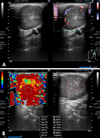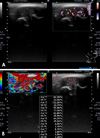Abstract
Purpose
To evaluate the usefulness of shear wave elastography in the diagnosis of oral and maxillofacial diseases.
Materials and Methods
Ten patients with oral and maxillofacial diseases and 28 volunteers drawn from our student doctors were examined by shear wave elastography with a 14-MHz linear transducer using an Aplio 300 apparatus (Canon Medical Systems, Otawara, Japan). A statistical analysis of the shear elastic modulus (kPa) of healthy tissue (the sublingual gland, submandibular gland, anterior belly of the digastric muscle, and geniohyoid muscle) in the 28 volunteers was performed using 1-way repeated measures analysis of variance with the Tukey honest significant difference test. The maximum shear elastic modulus (kPa) of 8 patients with squamous cell carcinoma (SCC) and 2 patients with benign lesions was evaluated with the Mann-Whitney U test. The analysis used a 5% significance level.
Results
The mean shear elastic modulus of the sublingual gland (9.4±3.7 kPa) was lower than that of the geniohyoid muscle (19.2±9.2 kPa, P=.000) and the anterior belly of the digastric muscle (15.3±6.1 kPa, P=.004). The maximum shear elastic modulus of the SCCs (109.6±14.4 kPa) was higher than that of the benign lesions (46.4±26.8 kPa, P=.044).
Ultrasonography has been widely accepted as a valuable diagnostic tool for head and neck diseases. Color Doppler ultrasonography is effective for the diagnosis of oral and maxillofacial diseases.1 Strain elastography with ultrasonography is a relatively new imaging technique that has been found to be effective for the differential diagnosis of cervical lymph node metastasis.23 In recent years, strain elastography of the tongue has been found to be effective for differentiating healthy tissues and squamous cell carcinoma (SCC).45
Shear wave elastography is a recently developed method that uses push pulses to stress tissues and an ultrafast ultrasound imaging technique to detect the induced shear waves.678 Elasticity values have been determined for different tissues using shear wave elastography.910 Shear wave elastography is an acceptable method for diagnosing cervical lymph node metastasis, although its diagnostic criteria and reliability need to be further studied.11121314 Furthermore, the usefulness of shear wave elastography for diagnosing oral and maxillofacial diseases and differentiating pathological lesions from healthy tissue has not been reported in the literature. This study aimed to evaluate the usefulness of shear wave elastography in the diagnosis of oral and maxillofacial diseases and the distinction of pathological lesions from healthy tissue (the sublingual gland, submandibular gland, anterior belly of the digastric muscle, and geniohyoid muscle).
This prospective study was approved by the ethics committee of our institution. Ten patients (8 males and 2 females; mean age, 72.6 years [range, 34–87 years]) with oral and maxillofacial diseases and 28 volunteers drawn from our student doctors (12 males and 16 females; mean age, 23.9 years [range, 23–26 years]) were examined by B-mode, color Doppler sonography and shear wave elastography with a 14-MHz linear transducer using an Aplio 300 apparatus (Canon Medical Systems, Otawara, Japan) at our university hospital from October 2017 to March 2018. Informed consent was obtained from all volunteers and patients. The volunteers were healthy and had no severe medical history or symptoms. The histopathological diagnoses of oral and maxillofacial diseases were obtained by surgery or biopsy in all cases after performing ultrasonography.
The ultrasonography examinations were performed by an experienced radiologist with more than 20 years of experience. On B-mode ultrasonography, the pathological lesions were assessed for their boundaries, echogenicity, and internal architecture. Color Doppler ultrasonography was performed to evaluate the vascular signals within the lesions. The integrated shear wave elastography software allowed the operator to place regions of interest (ROIs) of various sizes within the elastography window, and automatically displayed shear elastic modulus data (kPa) for each ROI. Three ROIs with similar sizes were measured in each normal structure and lesion to obtain the shear elastic modulus (kPa). The quantitative indices of the shear elastic modulus (kPa) in healthy tissue were measured for the sublingual gland, submandibular gland, anterior belly of the digastric muscle, and geniohyoid muscle in the volunteers. Shear elastic modulus values for lesions and normal tissue areas as controls were also measured in 8 patients with SCC and 2 patients with benign lesions (1 pleomorphic adenoma and 1 cavernous hemangioma). The values from the healthy control tissues were measured at a significant distance from the areas affected by the diseases.
The shear elastic modulus of normal structures was compared between men and women using the Mann-Whitney U test. The statistical analysis of the shear elastic modulus of normal structures was performed using 1-way repeated-measures analysis of variance with the Tukey honest significant difference test. The maximum shear elastic modulus (kPa) of the SCC and benign lesions was evaluated using the Mann-Whitney U test. The analyses were performed using SPSS version 24 (IBM Japan, Tokyo, Japan) with a 5% significance level.
Table 1 presents the shear elastic modulus values of healthy tissue in the oral and maxillofacial region. The differences in the shear elastic modulus of each of the normal structures (sublingual gland, submandibular gland, anterior belly of the digastric muscle, and geniohyoid muscle) between males and females was not significant.
Table 2 presents findings regarding the ultrasonographic appearance of the oral and maxillofacial lesions. Of the 8 SCCs, 6 had unclear boundaries, 8 were isoechoic relative to the adjacent tissues, 8 had a heterogeneous appearance on B-mode ultrasonography, and 7 had internal vascularity using color Doppler sonography.
Table 3 shows the shear wave elastography findings for the oral and maxillofacial healthy tissue and lesions. The mean shear elastic modulus of the sublingual gland (9.4±3.7 kPa) was lower than that of the geniohyoid muscle (19.2±9.2 kPa, P=.000), the anterior belly of the digastric muscle (15.3±6.1 kPa, P=0.004), and the submandibular gland (13.2±4.7 kPa, P=0.117). The maximum shear elastic modulus of the SCCs (109.6±14.4 kPa) was higher than that of the benign lesions (46.4±26.8 kPa, P=.044) (Figs. 1 and 2).
This study demonstrated the effectiveness of shear wave elastography of the oral and maxillofacial region. Shear wave elastography is useful for the objective and quantitative diagnosis of oral and maxillofacial lesions.
Arda et al.9 showed that the mean elasticity values for the submandibular glands were 11.1±3.2 kPa for males and 10.8±3.1 kPa for females. In this study, the mean elasticity values for the submandibular glands were 12.4±4.2 kPa for males and 13.8±5.1 kPa for females. Furthermore, our results showed that the mean shear elastic modulus of the sublingual gland (9.4±3.7 kPa) was lower than that of the geniohyoid muscle (19.2±9.2 kPa, P=.000), the anterior belly of the digastric muscle (15.3±6.1 kPa, P=.004), and the submandibular gland (13.2±4.7 kPa, P=.117). The authors therefore concluded that evaluating the shear elastic modulus of healthy tissue is valuable for the differential diagnosis of oral and maxillofacial diseases.
Bhatia et al.6 showed that mean elasticity values for mucoepidermoid carcinoma, pleomorphic adenoma, and Warthin tumor were 107.0±44.2 kPa, 22.5±12.4 kPa, and 16.9±4.8 kPa, respectively. Desmots et al.13 reported that head and neck lymph nodes with metastasis were stiffer (72.4±59.0 kPa) than benign nodes (23.3±25.3 kPa). In this study, the maximum shear elastic modulus of the SCCs (109.6±14.4 kPa) was higher than that of the benign lesions (46.4±26.8 kPa, P=.044). As an explanation of why the malignant tumors had higher shear elastic modulus values than the benign or normal tissue, Ogura et al.15 showed that the consistency of tongue carcinoma correlated with tumor thickness and other clinical or histopathological findings. We therefore suggest that the shear elastic modulus is linked to the histopathological differences between benign and malignant diseases.
Suh et al.14 showed that the heterogeneous histology of lymph nodes with metastasis was more accurately reflected by the maximum value. Therefore, this study analyzed the maximum shear elastic modulus values, rather than the mean values.
There were several limitations to this study. All volunteers were relatively young because they were drawn from our student doctors. Our study also had a small sample of benign lesions. Therefore, further studies of healthy tissue in older individuals with a larger number of patients are necessary to confirm the diagnostic utility of this modality.
In conclusion, this study showed that shear wave elastography was useful for diagnosing oral and maxillofacial diseases. Shear wave elastography is an effective technique for the objective and quantitative diagnosis of oral and maxillofacial diseases.
Figures and Tables
 | Fig. 1Ultrasonograms of a pleomorphic adenoma of the left submandibular gland in an 84-year-old man. A. The lesion shows clear boundaries and is isoechoic and heterogeneous, with vascular signals within the lesion. B. T1 (65.3 kPa), T2 (20.0 kPa), T3 (34.1 kPa), and T4 (29.8 kPa) show the shear elastic modulus values of this submandibular gland tumor. |
 | Fig. 2Ultrasonograms of a squamous cell carcinoma on the right side of the buccal mucosa in a 56-year-old man. A. The lesion shows unclear boundaries, and is isoechoic and heterogeneous, with vascular signals within the lesion. B. T1 (64.3 kPa), T2 (122.2 kPa), T3 (93.9 kPa), and T4 (63.8 kPa) show the shear elastic modulus values of this buccal mucosal tumor. |
Table 1
Shear elastic modulus (kPa) of healthy tissue in the oral and maxillofacial region (mean±standard deviation; range)

References
1. Ogura I, Kaneda T, Sasaki Y, Sekiya K, Tokunaga S. Characteristic power Doppler sonographic images of tumorous and non-tumorous buccal space lesions. Dentomaxillofac Radiol. 2013; 42:20120460.

2. Acu L, Oktar SÖ, Acu R, Yücel C, Cebeci S. Value of ultrasound elastography in the differential diagnosis of cervical lymph nodes: a comparative study with B-mode and color Doppler sonography. J Ultrasound Med. 2016; 35:2491–2499.
3. Turgut E, Celenk C, Tanrivermis Sayit A, Bekci T, Gunbey HP, Aslan K. Efficiency of B-mode ultrasound and strain elastography in differentiating between benign and malignant cervical lymph nodes. Ultrasound Q. 2017; 33:201–207.

4. Shingaki M, Nikkuni Y, Katsura K, Ikeda N, Maruyama S, Takagi R, et al. Clinical significance of intraoral strain elastography for diagnosing early stage tongue carcinoma: a preliminary study. Oral Radiol. 2017; 33:204–211.

5. Ogura I, Sasaki Y, Sue M, Oda T. Strain elastography of tongue carcinoma using intraoral ultrasonography: a preliminary study to characterize normal tissues and lesions. Imaging Sci Dent. 2018; 48:45–49.

6. Bhatia KS, Cho CC, Tong CS, Lee YY, Yuen EH, Ahuja AT. Shear wave elastography of focal salivary gland lesions: preliminary experience in a routine head and neck US clinic. Eur Radiol. 2012; 22:957–965.

7. Bhatia KS, Tong CS, Cho CC, Yuen EH, Lee YY, Ahuja AT. Shear wave elastography of thyroid nodules in routine clinical practice: preliminary observations and utility for detecting malignancy. Eur Radiol. 2012; 22:2397–2406.

8. Dieterich AV, Andrade RJ, Le Sant G, Falla D, Petzke F, Hug F, et al. Shear wave elastography reveals different degrees of passive and active stiffness of the neck extensor muscles. Eur J Appl Physiol. 2017; 117:171–178.

9. Arda K, Ciledag N, Aktas E, Aribas BK, Köse K. Quantitative assessment of normal soft-tissue elasticity using shear-wave ultrasound elastography. AJR Am J Roentgenol. 2011; 197:532–536.

10. Azizi G, Keller JM, Mayo ML, Piper K, Puett D, Earp KM, et al. Thyroid nodules and shear wave elastography: a new tool in thyroid cancer detection. Ultrasound Med Biol. 2015; 41:2855–2865.

11. Azizi G, Keller JM, Mayo ML, Piper K, Puett D, Earp KM, et al. Shear wave elastography and cervical lymph nodes: predicting malignancy. Ultrasound Med Biol. 2016; 42:1273–1281.

12. Cheng KL, Choi YJ, Shim WH, Lee JH, Baek JH. Virtual touch tissue imaging quantification shear wave elastography: prospective assessment of cervical lymph nodes. Ultrasound Med Biol. 2016; 42:378–386.

13. Desmots F, Fakhry N, Mancini J, Reyre A, Vidal V, Jacquier A, et al. Shear wave elastography in head and neck lymph node assessment: image quality and diagnostic impact compared with B-mode and Doppler ultrasonography. Ultrasound Med Biol. 2016; 42:387–398.





 PDF
PDF ePub
ePub Citation
Citation Print
Print




 XML Download
XML Download